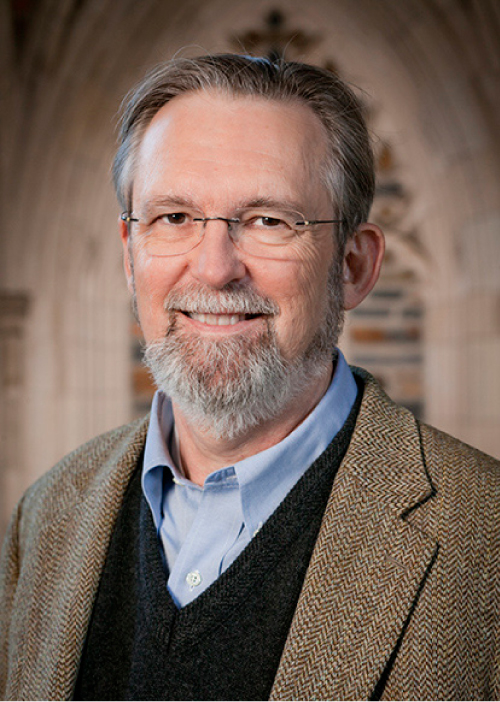



The Rev. Richard Hays
DUKE DIVINITY SCHOOL

The Rev. Melanie Johnson-DeBaufre
DREW UNIVERSITY THEOLOGICAL SCHOOL
The Bible is not just another ancient book of human wisdom – it is God’s Word, given to tell humans how they can know God.
The Bible is not a book of science, even though it tells of God’s power in the creation of the universe and all that is in it. It is not a book of history, even though it tells of some of the major events in the ancient world.
It is unlike any other book.
The Bible says of itself that it is the inspired word of God, or “God-breathed” (2 Timothy 3:16; 2 Peter 1:21). It unfolds as a divine love story between the Creator God and humankind – the object of God’s love. The Bible tells of God’s interaction with humankind.
The Bible is somewhat like a library. It is actually a collection of books: 66 books, 39 in the Old Testament and 27 in the New Testament. Those books were written over many centuries. They were eventually brought together into their present form to form the canon, the books that have been accepted as authoritative for the Christian faith and life since the fourth century of the Common Era (the years since Christ’s birth).
Some Bibles also include the apocrypha, a collection of books that some Christians consider a part of the biblical canon but most Protestants do not, but that have value for readers.
The first “collection” was the first five books of the Bible (often called the Torah or Pentateuch). As time went on, other books were added, including some that told of God’s dealings with people, as well as the words of the prophets and other writings. The Old Testament, as it is today, was finished about four centuries before the time of Jesus. Christians wrote the books of the New Testament within a few decades of Jesus’ earthly life.
The most important fact about the Bible, however, is that it isn’t just another ancient book of human wisdom – it is God’s word, given to tell humans how they can know God, how they can have a relationship with God.
The central theme of the Bible is God’s gracious way of salvation – God providing deliverance from sin and spiritual death through repentance and faith. In the Old Testament, the concept of salvation is rooted in Israel’s deliverance from Egypt and the giving of the Law in the book of Exodus. In the New Testament, salvation is accomplished through the sacrificial death of Jesus Christ on the cross, Resurrection from the dead and ascension into heaven and the coming of the Holy Spirit.
The Gospels
The writings in the New Testament are the basis for much of how Christians view God.
The Gospels, the first four books in the New Testament, provide insights into the nature and personhood of Jesus. Each book is a witness to Jesus, his life on earth as a human man and the divine son of God, his Crucifixion, death and Resurrection.
While not contradicting each other, each Gospel shows Jesus in a slightly different light. Just as four eyewitnesses to an event may each tell the truth about what they saw, they would not all have seen events unfold in exactly the same way.
“The diversity of the Gospels is important for several reasons,” said the Rev. Melanie Johnson-DeBaufre, associate professor of New Testament and early Christianity at Drew University Theological School in Madison, N.J.
“Theologically, they are a testimony to the responsiveness of the Gospel to different contexts and emphases,” she said. “That is, they give us room to think about God’s good news and of Jesus Christ in ways that speak to real people in real worlds. Life is not generic, and neither are the Gospels.”
Historically, the Gospels serve as a reminder that Christians have also always been diverse.
“There are even more gospels in the tradition that are outside the canon,” Johnson-DeBaufre continues. “This multiplicity challenges us to ask where we see the truth of God and to consider what kinds of debates and divergences that Christian communities have been through.”
Johnson-DeBaufre and others describe the different views.
Matthew was written by a Jewish follower of Jesus who portrays him as a challenging teacher and healer who calls people to right living. By tracing Jesus’ lineage back to Abraham, Matthew emphasizes Jesus’ Jewish heritage. Matthew’s account of the Resurrection has Jesus appearing before the women who had come to care for his body. He instructs the women to tell the disciples to meet him in Galilee. They do and are stunned and overjoyed to know he is alive.
Mark was written for followers living outside Galilee. It emphasizes the suffering required of those who follow the way of Jesus and God’s kingdom. The writer tells of Jesus performing miracle after miracle – and portrays him as a mystery. Who is this Jesus? It seems that only demons, women and other socially marginal people know him. In Mark’s Gospel, it is only at his death that Jesus’ identity is revealed. Ironically, a Roman soldier says that Jesus was truly God’s son.
Luke was written by a well-educated person who wrote the story of Jesus in the style of the other histories of ancient people. Tradition holds that Luke was a physician whose telling of the story of Jesus’ birth is the one familiar to most people. He tells that Jesus was born in Bethlehem, the city of King David, drawing a parallel between the ancient king of Israel and the new king. Luke offers a sense of joy missing in the other Gospels. It begins with the joyful birth of Jesus and ends with the joyful ascension of Jesus into heaven after his death and Resurrection.
John offers less of a biography of Jesus and more of a philosophical meditation on the Divine Christ as the Torah (or Word) of God. In John’s Gospel, Jesus speaks in long monologues, openly proclaiming his divinity and straight-out saying the only way to the Father and salvation is through him. John did write of Jesus’ Crucifixion and Resurrection. As Jesus appears to the disciples after the Resurrection, they see who he is and believe.
Foundational
Throughout the Bible, a love story from God to humankind unfolds.
“If you look at the whole story – Genesis through Revelation – Jesus is the climax of God’s action to redeem the world,” said the Rev. Richard Hays, dean and George Washington Ivey professor of New Testament at Duke Divinity School in Durham, N.C.
“When people read the Bible, they aren’t just reading a book of spiritual advice, not just something that is offering people some sort of magic pill – just believe one or two things and you’ll be saved,” he said. “They are being invited to join in the much longer history of God’s people and to participate in God’s action of restoring a broken world.
“It’s a story of God working to transform human life and bring humanity into relationship with God and with each other.”
Polly House is a freelance writer based in Nashville, Tenn. Sources used to develop this article include www.pbs.org/seaarc/?q=bible, www.umc.org/what-we-believe/our-christian-roots-the-bible and The Asbury General Commentary (Zondervan, 1992).
To learn more about the Bible
How to Read the Bible, Harvey Cox (Harper Collins, 2015)
Making Sense of the Bible, the Rev. Adam Hamilton (Harper Collins, 2014)
The Handy Bible Answer Book, Jennifer R. Prince (Visible Ink Press, 2014)
What Is the Bible? the Rev. Anne Robertson (CreateSpace, 2012)
Introducing the Old Testament, the Rev. Anne Robertson (CreateSpace, 2013)
Introducing the New Testament, the Rev. Anne Robertson (CreateSpace, 2014)